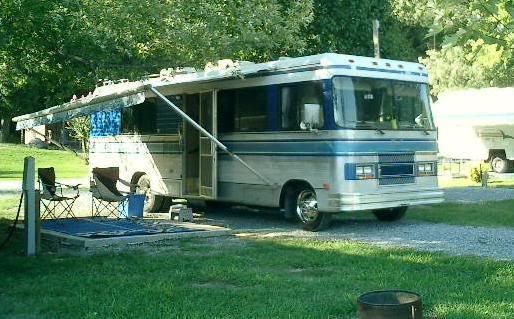Page 1 2
Go to...  | Start A New Topic  | Search  | Notify  | Tools  | Reply To This Topic  |  |
will be changing oil in Barth and seeking guidance on what would be the correct oil to use in a 1985 Barth with 454 and 58,000 miles. Mary Don't mess with us old folks, we don't get old by being stupid! 1968 Barth trailer, 1975 Barth Motorhome and 1985 Barth Motorhome | |||
|
| First Month Member |
. How cold does it get overnight before your coldest start? Block heater? . 84 30T PeeThirty-Something, 502 powered | |||
|
No block heater, and freezing is about as low as it gets usually. Mary Don't mess with us old folks, we don't get old by being stupid! 1968 Barth trailer, 1975 Barth Motorhome and 1985 Barth Motorhome | ||||
|
| ||||
|
 6/12 6/12Formally known as "Humbojb"  |
I was talking to Bill NY about this in Washington. I've used synthetic 10W30 and Bill thought that was a little light and suggested 10W40. Next oil change, I'll do that. I change it every 5000 miles, including filter. Jim PS I use Amsoil. Mobil 1 is in all my cars/trucks.
| ||||||||||||
|
| First Month Member |
Preamble: Selecting an oil is like selecting a way to save your soul from eternal damnation......there are lots of strong opinions, but it boils down to faith. Perhaps even in the Kierkegaardian sense. You just gotta believe. Short Answer: SAE30 Slightly Longer Answer: As long as your oil temp is never lower than 30-40 degrees on a cold start, use SAE30 from a reputable maker. Long Answer: Most oil company sites tell you to use what the manufacturer says. HA! My 1984 truck manual says all 49 states should use SAE 30 above 40 deg oil temp. 20W20 above 20 15W40 above 10 10W30 above 0 California should use SAE30 above 40 20W20 above 20 15W40 above 10 10W30 above 0 No idea why. My GM MH chassis manuals say SAE30 (preferred) above 40 20W20 above 20 15W40 above 10 10W30 above 0 They also say, "As a rule of thumb, in heavy duty applications and sustained expressway driving, SAE30 is more satisfactory than multiple viscosity oils. Multi viscosity oils have the advantage of easier cold weather cranking and initial lubrication." And: “10W40 is not recommended on account some contained inadequate additives, or none at all and some did not meet viscosity requirements. Testing showed 10W40 was more prone to high-mileage ring sticking.” I don't know if that last paragraph applies today. There were also stories of inadequate cam lubrication with thicker oils. HOWEVER: My 95 truck owner handbook says for light duty service, use 5W30 at all temps. For heavy duty service, 10W30 is preferred above 0. Use 5W30 for colder than 0 and if the temp does not get above 60. They say no other viscosities should be used. I would question a recommendation like that, as the relation between outside air temp on a running engine is dependent on a number of factors. Presence of an oil cooler, size of radiator installed by factory, engine temp, speed, load, etc. Oil temp is the only figure I would use in viscosity selection. Outside temp is only a loose indicator. Now……You have to ask yourself if the 95 recommendations are different than the 84 because the engines are different, the oil is different or the pollution and mileage laws are different. So, getting back to a recommendation, SAE30 with 10W30 a close second, depending on how cold the oil is for winter starts. 15W40 could be good for an engine with some wider clearances that used too much oil. However, keep in mind that 454s tend to use a little more oil than other engines, anyway. I have family in cold states who use SAE30 year round, with pan or block heaters on cold nights. That is how much they believe in the advantages of SAE30. And, some of this could be lingering mistrust of multigrades from times past. It used to be that you could see by your oil pressure gauge how a multigrade broke down sooner than a single grade, and a wider spread multigrade broke down faster than, say, a 10W30. Somewhere, I have a chart showing how well cylinder walls are protected by different grades at different temperatures. At the middle of the temp range, all were pretty good. At both ends, SAE30 was noticeably better. If memory serves, it was 10-15 years ago, done by GM. Having said all that, I really like Mobil 1, but I can't find it in SAE30. So, I use 10W30 in my fresh 502 that has a cap recommending 5W30. However, synthetic oils can make an older engine start to leak. I have had it happen twice. Once, in a 95 engine with about 35K miles on it, the rear main seal had the rubber part come unglued from the metal part. Still have it somewhere as evidence for nonbelievers. In some circles, it is considered heresy or even apostasy to even mention anything about leaks with synthetic oil, but I am not the only old wife with leak experience. The other instance was a front crank seal that just dribbled. I switched back to mineral oil and the leak slowly got better. . 84 30T PeeThirty-Something, 502 powered | |||
|
Captain Doom |
This was the result of early viscosity index improvers (VIIs), which were not shear stable, and where the remains of the sheared components manifested in ring belt and valve deposits. Contemporary VIIs are shear-stable (hence the mfrs' recommendations for Rotella T or DelVac 15W40 in diesels - unthinkable 30 years ago).
~'90 and later engines were expected to get better fuel economy, and a quick way to do that is to reduce the viscosity of the motor oil. The oil is also different - especially the VIIs. API Service Claases have gone from SD in the early-to-mid '70s to SM today. Each class is backwards-compatible. Bottom line: The rationale for using single-weight motor oil is a relic of yesterday - but it is cheaper. However, most brands have their best additive package in multigrades. SAE 30, 10W30, or 10W40 will all be fine (5W30 or 5W40 for cold-weather starting).
They may make an engine start to leak, but it's not the "synthetic" part - it's upgraded additive packages, especially the detergent-dispersents - in the synthetics, which are the top-of-the-line and contain the most potent additives. Except for the purity of the base stock, synthetics are the same as from-the-ground stocks. That additive package may affect the flexibility of seals and the strength of adhesives. Rusty '94 28' Breakaway: MilSpec AMG 6.5L TD 230HP Nelson and Chester, not-spoiled Golden Retrievers Sometimes I think we're alone in the universe, and sometimes I think we're not. In either case the idea is quite staggering. - Arthur C. Clarke It was a woman who drove me to drink, and I've been searching thirty years to find her and thank her - W. C. Fields | |||
|
| First Month Member |
Do synthetics have more potent additives than top of the line dyno oil from good manufacturers? . 84 30T PeeThirty-Something, 502 powered | |||
|
Captain Doom |
That's really hard to say - no oil company releases data (Amsoil won't even release ASTM data, which is why I won't use it). The additive package may be slightly different, as (odd as it may seem) "impurities" attached to crude oil (and its refined base stock) molecules make it more "additive susceptible". Translation: It's easier to blend a crude-based stock with additives. OTOH, a crude-based stock might need more (quantity, not necessarily potency) additives. Anyway, whatever the cause of seal issues (the most common) with synthetics seem to have been overcome with contemporary products. IMHO, synthetics are worth the cost where the vehicle doesn't accumulate enough miles for normal change in six months. My Lexus gets Mobil 1; the (diesel) Ford van and StaRV II, Rotella T 15W40. In the long view, synthetic motor oils are a solution seeking a real problem. Rusty '94 28' Breakaway: MilSpec AMG 6.5L TD 230HP Nelson and Chester, not-spoiled Golden Retrievers Sometimes I think we're alone in the universe, and sometimes I think we're not. In either case the idea is quite staggering. - Arthur C. Clarke It was a woman who drove me to drink, and I've been searching thirty years to find her and thank her - W. C. Fields | |||
|
| First Month Member |
Both of my seal incidents were in the last 3 or 4 years. Does that fall under contemporary? The front seal car now has mineral oil. The rear seal car, since it has a new seal, still gets Mobil 1. The rear seal issue is particularly curious, because the engine is an LT1 (pretty much) Corvette engine. The almost identical LT4 of the same year came with Mobil 1 due to higher oil temps. The only thing I can think of is that the seal that failed was not a CR, National or other familiar brand. The factory must have used an off-brand substitute. I don't haunt Corvette forums, but my next door neighbor does, and has an LT4 of the same year. He says he never heard of my situation. Rear main seals are no fun. My luck. . 84 30T PeeThirty-Something, 502 powered | |||
|
Captain Doom |
3-4 years would be contemporary; the claim of "issues" (I love that description) being cured dates back over 5. Rusty '94 28' Breakaway: MilSpec AMG 6.5L TD 230HP Nelson and Chester, not-spoiled Golden Retrievers Sometimes I think we're alone in the universe, and sometimes I think we're not. In either case the idea is quite staggering. - Arthur C. Clarke It was a woman who drove me to drink, and I've been searching thirty years to find her and thank her - W. C. Fields | |||
|
| The Old Man and No Barth |
Apropos nothing serious, differing opinions on motor oils have been with us a long time. Sometime back in the '30s or '40s, Chevron came out with a brand new oil with supposedly magical powers. They called it "RPM," which remains their brand today. Skeptical old time mechanics then said RPM stands for, "Ruins Perfect Motors.' | |||
|
 6/12 6/12Formally known as "Humbojb"  |
bill H, I ran Mobil 1 in a '96 Caprice with an LT1, (police special) for 275000 miles. Changed oil and filter every 5000 miles. It didn't use any oil at all between oil changes all the way to 275000 miles when I sold it. It also got 27mpg highway. Truly a great car. (And it was very fast!) Jim
| ||||||||||||
|
| First Month Member |
Yeah. I worked with a mechanic who had a similar story with his car. I don't remember the numbers any more, but he had a long commute, so the car got a lot of steady-state usage and racked up the miles fast. His experience also illustrated the longevity of an engine with lots of steady state operation. Stories like yours and his are why I use Mobil 1. My Jag is geared a little differently, so my mileage is not as good as yours, though. When I stick in a Posi from my donor XJS, I might do better on the gearing. That LT1 is a jewel, isn't it? I have a friend who had a Buick wagon with one. He tricked it up a little and regeared the diff for towing his ski boat. Without the boat, it was the ultimate Q ship from stoplight to stoplight. A lot of muscle cars and Rice Rockets experienced Shock and Awe over that car. . 84 30T PeeThirty-Something, 502 powered | |||
|
Just some off the wall comments. One - Mobile 1 is available in straight weights. Just try and find it though. Two - Detroit Diesel still does not recommend muti-weight oils for the two strokes do to shearing (what ever that is). Because of this Mobile developed a straight weight. Three - this has nothing to do with Mary's original question. '92 Barth Breakaway - 30' 5.9 Cummins (6B) 300+ HP 2000 Allison Front entrance | ||||
|
| Powered by Social Strata | Page 1 2 |
| Please Wait. Your request is being processed... |
|
This website is dedicated to the Barth Custom Coach, their owners and those who admire this American made, quality crafted, motor coach.
We are committed to the history, preservation and restoration of the Barth Custom Coach.
We are committed to the history, preservation and restoration of the Barth Custom Coach.



